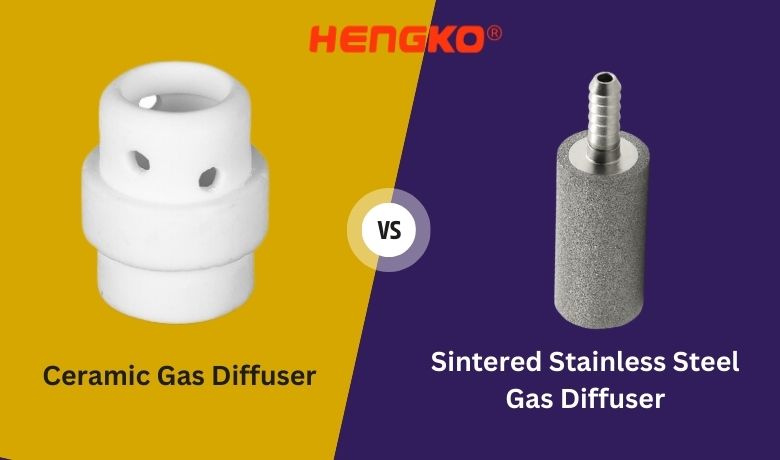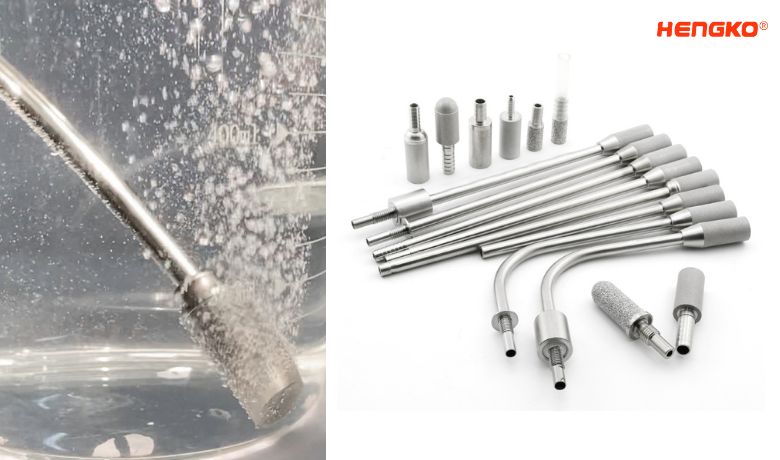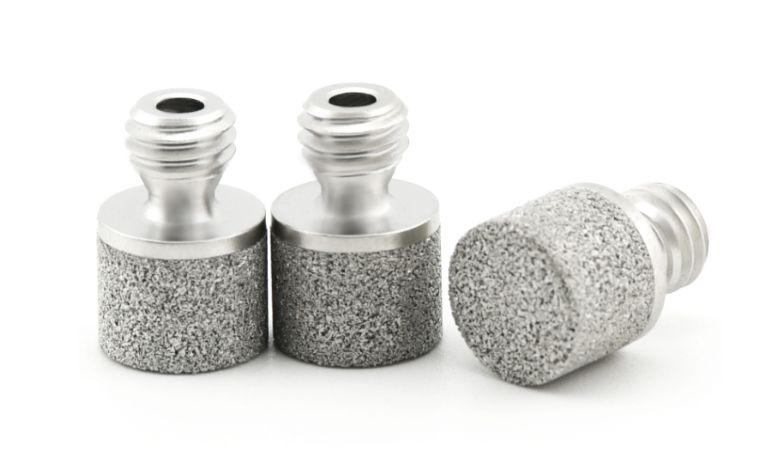
Why it is more and more popular of Sintered Stainless Steel Gas Diffuser ?
Sintered stainless steel gas diffusers are gaining popularity for several reasons. Here are some of the factors contributing to their increasing popularity:
-
Superior Performance: Sintered stainless steel gas diffuser offer excellent performance characteristics. They provide precise and uniform pore sizes, allowing for efficient and consistent gas distribution. This results in improved gas transfer rates, making them highly effective in various applications such as water treatment, aeration, and gas dispersion.
-
Durability and Longevity: Sintered stainless steel diffusers are known for their exceptional durability. They can withstand high pressures, temperature variations, and exposure to harsh chemicals without degrading or breaking. This longevity reduces the need for frequent replacements, saving both time and money.
-
Chemical Resistance: Stainless steel is highly resistant to corrosion caused by chemicals, making it suitable for use in diverse industrial and environmental conditions. This resistance ensures the diffusers remain functional even in aggressive environments, such as those involving ozone, chlorine, or acidic substances.
-
Versatility: Sintered stainless steel gas diffusers are versatile and can be used in a wide range of applications. They find utility in water and wastewater treatment systems, aquaculture, industrial processes, aeration systems, and more. The ability to adapt to different environments and requirements contributes to their growing popularity.
-
Easy Maintenance: Stainless steel diffusers are relatively easy to clean and maintain. They can be backflushed, chemically cleaned, or simply wiped to remove any accumulated debris or fouling. This ease of maintenance ensures consistent performance and prolongs the lifespan of the diffusers.
-
Increasing Availability: With the growing demand for sintered stainless steel gas diffusers, their availability has also increased. They are now more readily accessible in the market, making it easier for users to procure and integrate them into their systems.
-
Advancements in Manufacturing Techniques: Advances in manufacturing techniques have made it possible to produce sintered stainless steel diffusers with precise and uniform pore structures. This has led to improved performance and increased confidence in their reliability.
The combination of excellent performance, durability, chemical resistance, and versatility has contributed to the rising popularity of sintered stainless steel gas diffusers. As industries seek more efficient and long-lasting solutions, these diffusers have become a preferred choice in various applications.

What is Ozone Water Treatment Equipment , Why Need to Use Gas Diffuser ?
Ozone water treatment equipment is a system designed to utilize ozone gas for the purification and treatment of water. Ozone (O3) is a highly reactive form of oxygen that is used as a powerful oxidizing agent and disinfectant in water treatment processes.
Gas diffusers are essential components of ozone water treatment equipment. They are used to introduce ozone gas into the water, ensuring efficient dissolution and contact between the gas and the water. The main purpose of using gas diffusers in ozone water treatment systems is to maximize the transfer of ozone gas into the water for effective treatment. Here's why gas diffusers are necessary:
-
Enhanced Mass Transfer: Gas diffusers promote efficient mass transfer by creating small bubbles of ozone gas in the water. These bubbles increase the contact surface area between the gas and water, allowing for enhanced transfer of ozone into the water.
-
Improved Ozone Utilization: Proper dispersion of ozone gas through diffusers ensures optimal utilization of ozone. By evenly distributing the gas throughout the water, it maximizes the contact time and exposure of ozone to contaminants, facilitating effective disinfection and oxidation.
-
Uniform Treatment: Gas diffusers help achieve uniform ozone distribution within the water, ensuring consistent treatment throughout the system. This is particularly important in large-scale water treatment applications, where uniform disinfection or oxidation is crucial for maintaining water quality and safety.
-
Reaction Time Control: Gas diffusers play a role in controlling the reaction time between ozone and water. The size and design of the diffusers can be adjusted to control the bubble size and residence time, allowing for precise control over the treatment process and ensuring optimal results.
-
System Efficiency: Using gas diffusers in ozone water treatment equipment increases the overall efficiency of the system. It enables effective utilization of ozone gas, reducing ozone wastage and minimizing the operational costs associated with ozone production or generation.
In summary, gas diffusers are essential in ozone water treatment equipment to ensure efficient and uniform dissolution of ozone gas into the water. They enhance mass transfer, improve ozone utilization, and enable precise control over the treatment process. By utilizing gas diffusers, ozone water treatment systems can achieve effective disinfection, oxidation, and purification of water for various industrial, municipal, and environmental applications, so choose right Ozone Diffuser Stone for your equipment is your first need to do, Check HENGKO products, or contact us by email ka@hengko.com
Why it's better to replace ceramic gas diffusers by sintered stainless steel in ozone water treatment equipment system ?
Replacing ceramic gas diffusers with sintered stainless steel in ozone water treatment equipment systems offers several advantages. Here are some reasons why it's considered better:
-
Enhanced Durability: Sintered stainless steel diffusers are known for their superior durability compared to ceramic diffusers. They can withstand higher pressures and are less prone to cracking or breaking, ensuring longer service life.
-
Chemical Resistance: Ozone water treatment involves the use of chemicals, and sintered stainless steel is highly resistant to corrosion from ozone and other harsh chemicals. Ceramic diffusers, on the other hand, may be more susceptible to chemical degradation over time.
-
Improved Efficiency: Sintered stainless steel diffusers have precise pore sizes and distribution, allowing for more uniform bubble formation and distribution of ozone gas. This leads to improved mass transfer efficiency, maximizing the ozone utilization and enhancing the treatment process.
-
Higher Ozone Transfer Rates: Due to their well-defined pore structures, sintered stainless steel diffusers offer higher ozone transfer rates compared to ceramic diffusers. This means that a larger amount of ozone can be dissolved into the water, resulting in more effective water treatment.
-
Easy Maintenance: Sintered stainless steel diffusers are relatively easy to clean and maintain. They can be backflushed or cleaned with chemicals to remove any accumulated debris or fouling, ensuring consistent performance over time.
-
Cost-Effectiveness: Although sintered stainless steel diffusers may have a higher initial cost compared to ceramic ones, their longer lifespan and improved efficiency can result in cost savings in the long run. Reduced maintenance and replacement expenses contribute to the overall cost-effectiveness of stainless steel diffusers.
It's important to note that the choice between ceramic and sintered stainless steel diffusers may depend on specific application requirements and cost considerations. However, in ozone water treatment equipment systems, sintered stainless steel diffusers generally provide better performance and longevity, making them a preferred choice for many practitioners.

Ceramic Gas Diffuser Vs Sintered Stainless Steel Gas Diffuser
When comparing ceramic gas diffusers to sintered stainless steel gas diffusers, there are several factors to consider. Let's explore the characteristics of each type:
1. Material Composition:
1.1 Ceramic Gas Diffuser: Ceramic gas diffusers are made from various types of ceramics, such as alumina or zirconia. These materials are known for their high-temperature resistance, chemical inertness, and excellent thermal shock resistance.
1.2 Sintered Stainless Steel Gas Diffuser: Sintered stainless steel gas diffusers are composed of fine stainless steel powder that is compacted and sintered at high temperatures. The sintering process creates a porous structure within the stainless steel.
2. Porosity and Pore Size:
2.1 Ceramic Gas Diffuser: Ceramic diffusers can be manufactured with a wide range of pore sizes and porosities, allowing for precise control over gas flow rates and distribution.
2.2 Sintered Stainless Steel Gas Diffuser: The pore size and porosity of sintered stainless steel gas diffusers can also be tailored during the manufacturing process, but they generally offer a narrower range compared to ceramic diffusers.
3. Chemical Compatibility:
3.1 Ceramic Gas Diffuser: Ceramics are highly chemically inert, making ceramic gas diffusers suitable for a wide range of applications involving corrosive gases or liquids.
3.2 Sintered Stainless Steel Gas Diffuser: Stainless steel is generally resistant to corrosion, but certain aggressive chemicals may cause it to corrode over time. Sintered stainless steel gas diffusers are typically suitable for less demanding chemical environments.
4. Thermal Resistance:
4.1 Ceramic Gas Diffuser: Ceramics exhibit excellent thermal resistance and can withstand high temperatures without significant degradation. This makes ceramic diffusers suitable for applications involving elevated temperatures
4.2 Sintered Stainless Steel Gas Diffuser: Stainless steel also has good thermal resistance but may not perform as well as ceramics at extremely high temperatures.
5. Mechanical Strength:
5.1 Ceramic Gas Diffuser: Ceramics are brittle materials and can be prone to breakage under mechanical stress or impact. They require careful handling to avoid damage.
5.2 Sintered Stainless Steel Gas Diffuser: Stainless steel is a much stronger material compared to ceramics and can withstand mechanical stresses better.
In summary, ceramic gas diffusers excel in high-temperature applications and provide excellent chemical compatibility, while sintered stainless steel gas diffusers offer greater mechanical strength. The choice between the two will depend on the specific requirements of your application, considering factors such as temperature, chemical compatibility, gas flow rates, and mechanical stress.
Do You Know How many Types of Sintered Stainless Steel Gas Diffuser ?
There are several types of sintered stainless steel gas diffusers available, each with its own unique characteristics and applications. Here are some common types:
-
Sintered Stainless Steel Plate Diffuser:
- This type of diffuser consists of a thin, flat plate made of sintered stainless steel.
- The plate is manufactured by compacting and sintering stainless steel powder, creating a porous structure with uniform pore size distribution.
- Sintered stainless steel plate diffusers are often used in applications requiring fine bubble aeration, such as wastewater treatment or aquariums.
-
Sintered Stainless Steel Tube Diffuser:
- This type of diffuser is in the form of a cylindrical tube made of sintered stainless steel.
- The tube is produced by compacting and sintering stainless steel powder, resulting in a porous structure along the entire length of the tube.
- Sintered stainless steel tube diffusers are commonly used in aeration systems for wastewater treatment plants and industrial processes.
-
Sintered Stainless Steel Disc Diffuser:
- A sintered stainless steel disc diffuser is a circular disc-shaped component made of sintered stainless steel.
- The disc is created by compacting and sintering stainless steel powder, forming a porous structure with evenly distributed pores.
- This type of diffuser is frequently used in applications where aeration or gas distribution is required, such as water treatment and aquaculture.
-
Sintered Stainless Steel Sparger:
- A sintered stainless steel sparger is a specialized type of diffuser designed to introduce gas into liquids.
- It consists of a porous sintered stainless steel element attached to a pipe or tube, allowing gas to be dispersed as fine bubbles into the liquid medium.
- Sintered stainless steel spargers are commonly used in various industries, including pharmaceutical, chemical, and food processing, for applications such as gas-liquid reactions and mixing processes.
These are just a few examples of sintered stainless steel gas diffusers available in the market. The choice of diffuser type depends on factors such as the desired gas flow rate, bubble size, application requirements, and the specific environment in which they will be used.
How to Choose Right Sintered Stainless Steel Gas Sparge or Diffuser for Your Devices ?
When selecting the right sintered stainless steel gas sparge or diffuser for your devices, consider the following factors:
-
Gas Flow Rate: Determine the required gas flow rate for your application. This will help you choose a diffuser with appropriate porosity and pore size that can deliver the desired gas flow.
-
Bubble Size: Consider the desired bubble size for your application. If you need fine bubbles for efficient gas-liquid mass transfer, look for a diffuser that can produce smaller bubbles.
-
Chemical Compatibility: Assess the compatibility of the diffuser material with the gases or liquids it will come into contact with. Ensure that the stainless steel used in the diffuser is resistant to corrosion by the specific gases or liquids in your application.
-
Pressure and Temperature: Evaluate the operating pressure and temperature conditions in your system. Choose a diffuser that can withstand the pressure and temperature ranges required without experiencing degradation or failure.
-
Application Requirements: Consider the specific needs of your application. Different applications may require different types of diffusers. For example, if you need aeration in a wastewater treatment plant, a tube or plate diffuser might be suitable. If you require gas sparging in a chemical reaction, a specialized sparger may be necessary.
-
Longevity and Maintenance: Evaluate the expected lifespan of the diffuser and the maintenance requirements. Some diffusers may require periodic cleaning or replacement. Consider the ease of maintenance and the cost implications.
-
Supplier Expertise: Choose a reputable supplier or manufacturer with experience in providing sintered stainless steel gas sparges or diffusers. They can offer guidance based on your specific requirements and provide reliable and high-quality products.
-
Cost Considerations: Compare the costs of different options, considering factors such as initial purchase price, maintenance requirements, and expected lifespan. Balance the cost with the performance and durability of the diffuser.
By considering these factors, you can choose the right sintered stainless steel gas sparge or diffuser that aligns with your application's requirements, ensuring efficient and reliable gas distribution or sparging in your devices.
To OEM your special sintered metal gas diffuser, please feel free to contact HENGKO by email at ka@hengko.com.
Our team will be happy to discuss your requirements and provide you with customized solutions.
Reach out to us today and let's collaborate on your unique gas diffusion need
Post time: Jul-17-2023




